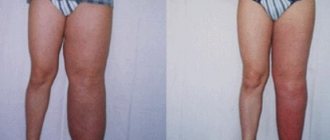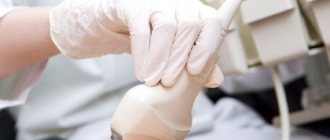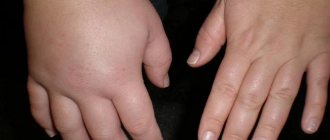Lymphedema is the accumulation of excess fluid between tissues. Most often, the disease affects the extremities (upper and lower). Lymphedema is associated with disruption of the function and integrity of the lymph nodes and vessels, which play the role of a filter in the body and are an important part of the immune system. Lymphedema leads to severe swelling of the arms and legs, which causes many problems: difficulty in moving, and the affected tissues are more susceptible to severe inflammation and infection. Treatment of the disease must begin at the first signs. In this case, the likelihood of inhibition and elimination of the pathological process increases significantly. Only a specialist can recognize lymphedema and prescribe adequate treatment.
Treatment of lymphedema in Moscow is performed at the Yusupov Hospital. There are doctors here who have extensive experience in eliminating such ailments. At the Yusupov Hospital, lymphedema is treated using effective therapy methods that help improve the patient’s condition and restore the functioning of the body’s systems.
Causes of lymphedema
Lymphedema occurs as a result of damage or removal of lymph nodes and blood vessels. This is a fairly common disease, the onset of which is more often found at a young age. There are two types of lymphedema:
- primary (congenital). Occurs in 6% of cases. Caused by congenital damage to the vessels of the lymphatic system;
- secondary (acquired). Occurs as a result of rupture, blockage or removal of lymphatic vessels.
Secondary lymphedema occurs in more than 90% of cases. Its development is provoked by surgical interventions, trauma, malignant neoplasms, vein thrombosis, and radiation therapy.
Patients who have undergone the following procedures are at risk of developing lymphedema:
- mastectomy with removal of lymph nodes;
- lumpectomy with removal of lymph nodes;
- combined cancer surgery;
- surgical treatment of testicular and prostate cancer;
- radiation therapy in the area of the lymph nodes;
- liposuction.
Lymphedema may appear several months after surgery or even several years later. Therefore, it is important to undergo preventive examinations on time, especially for patients who have undergone cancer treatment.
Lymphedema is quite common in women after mastectomy. However, this disease also affects men. There is a type of pathology called scrotal lymphedema. It is formed as a result of inflammatory disease of the lymph nodes of the groin area. As a result of pathology, dense formations appear in the scrotum area, deforming the organ and disrupting its functions.
Lymphatic System Information
Figure 1. Normal lymph drainage
The lymphatic system performs 2 functions:
- helps fight infections;
- promotes the outflow of fluid from different parts of the body.
Your lymphatic system is made up of lymph nodes, lymphatic vessels, and lymphatic fluid (see Figure 1).
- Lymph nodes are small, bean-shaped glands located along the lymphatic vessels. Your lymph nodes filter lymph fluid, trapping bacteria, viruses, cancer cells, and waste products.
- Lymphatic vessels are tiny tubes, like blood vessels, that carry fluid to and from the lymph nodes.
- Lymphatic fluid is a clear fluid that moves through the lymphatic system. It transports cells that help fight infections and other diseases.
The axillary lymph nodes are a group of lymph nodes in the axilla (armpit) that drain lymph fluid away from the breast and arm. The number of axillary lymph nodes is different for everyone. Axillary lymph node removal is an operation to remove a group of such nodes.
to come back to the beginning
Lymphedema of the lower extremities
Primary lymphedema of the lower extremities usually begins in the foot. It is characterized by dense swelling in the area of the toes, dorsum of the foot, and ankle joint. Secondary lymphedema is localized in the proximal limb and gradually spreads to the peripheral parts. At the initial stages, the skin is pale in color and painless. When pressed, a small depression appears in the skin, which quickly recovers. Over time, the swelling increases, skin folds disappear, and the so-called “elephantiasis” begins to form, when the leg loses its natural shape, acquiring a cylindrical shape.
Before starting therapy, it is necessary to make sure that the cause of edema is lymphedema of the lower extremities. Treatment begins with differential diagnosis. The disease is distinguished from edema associated with varicose veins, as well as damage to the kidneys and heart. To do this, the doctor evaluates the patient's medical history and prescribes an examination.
Primary lymphostasis and its causes
Congenital
Congenital lymphostasis is characterized by the presence of edema from birth; it can be observed even during intrauterine development of the fetus. Congenital lymphostasis can be either primary or secondary. In primary lymphostasis, edema occurs due to congenital pathology of the lymphatic vessels themselves (this may be a decrease in diameter or expansion, a decrease in the number of vessels, a complete absence of lymphatic vessels or capillaries). In secondary cases, swelling occurs due to external compression or trauma of blood vessels, for example, due to tight entanglement of the umbilical cord or amniotic bands.
Early (manifestation before 35 years of age)
Early lymphedema is characterized by the manifestation (onset) of edema before the age of 35. At the same time, in many cases it is possible to identify some kind of provoking event, after which swelling appeared. This could be pregnancy, a minor injury (for example, a sprain or bruise), physical overload of a limb, or an insect bite. Lymphedema can be hereditary (familial) in nature: Milroy's disease, Meij's disease, lymphatic edema in Shereshevsky-Turner syndrome, in combination with limb hypertrophy and malformation of blood vessels in Klippel-Trenaunay-Weber syndrome.
Late (manifestation after 35 years)
With late lymphedema, swelling appears after 35 years. Swelling with lymphedema most often occurs in the lower extremities, and often only one leg is swollen or, if swelling is in both legs, the swelling is asymmetrical. Lymphatic edema should be differentiated from edema accompanying other diseases. Edema of the lower extremities can occur with heart and vascular disease, kidney disease, rheumatic diseases, injuries and inflammation in the joints, hormonal disorders, infectious and parasitic infestations. Only a doctor can carry out a competent diagnosis.
Lymphedema of the upper extremities
Lymphedema of the arm after removal of the mammary gland is quite often observed in women who have undergone a similar operation. Lymphedema after mastectomy develops as a result of disruption of the integrity of the channels through which fluid passes. After surgery, the patient is required to undergo mandatory examination at certain intervals for timely diagnosis of lymphedema. Redness of the skin or pain in the arm may indicate the onset of inflammation, so the doctor should offer adequate treatment as soon as possible.
Symptoms of lymphedema of the upper extremities may include:
- swelling of the fingers, forearm, shoulders, chest;
- feeling of heaviness in the hands;
- change in skin tone;
- stiffness in joints, loss of flexibility;
- tightly fitting clothes or jewelry (rings, watches) in a certain place on the hand (and the item is of a suitable size).
Therapy begins after confirmation of the diagnosis of upper limb lymphedema. Treatment is determined by a specialist based on the patient’s medical history, the degree of the disease and the individual characteristics of the person.
What is hand lymphostasis?
Lymphostasis of the hands is a serious disease.
Due to a violation of the outflow of lymph, excessive accumulation of intercellular fluid rich in protein occurs, resulting in swelling of the soft tissues of the upper limb. With lymphostasis, there is an increase in the volume of subcutaneous fat due to edema. In the absence of proper treatment, gradual sclerosis and tissue fibrosis occur. If you do not seek professional help from qualified specialists, the disease progresses: swelling increases, changes appear on the skin in the form of hyperkeratosis, papillomatosis, maceration and ulceration, and infection occurs (nail and skin fungus, erysipelas).
Treatment of lymphedema
Treatment of the pathology usually follows a similar scenario, regardless of whether the lymphedema of the lower extremities is primary or secondary. Treatment of this pathology will consist of a set of measures that can improve the flow of fluids in the body and increase its protective functions.
Conservative treatment of lymphedema of the arms and legs will include the following elements:
- lymphatic drainage massage;
- diet;
- physiotherapy;
- wearing special compression stockings or a bandage.
Banding for lymphedema of the upper extremities is recommended to be performed during the day, during walks and movements. At night, you should place a pillow up to your feet or purchase a bed with a liftable foot end.
Medicine has not yet developed a complete method for treating lymphedema. The above methods are ways to stop the development of the process, but do not guarantee complete recovery. To maintain your health, it is necessary to visit specialists in a timely manner to prevent the progression of pathologies, especially for patients who are at risk of developing lymphedema.
When should you contact your healthcare provider?
Call your healthcare provider if you have the following symptoms:
- any part of the arm, hand, breast or torso on the treated side becomes: hot to the touch;
- red;
- more painful;
- more swollen
to come back to the beginning
Where is lymphedema treated in Moscow
Treatment of lymphedema is performed efficiently at the Yusupov Hospital. Qualified specialists work here who will select the most optimal method of treating the disease. Treatment of lymphedema at the Yusupov Hospital makes it possible to stop the development of pathology and improve the patient’s condition. The hospital has established oncology treatment and rehabilitation clinics, where they provide effective treatment for diseases of varying complexity and subsequent restoration of lost functions.
In the event of the development of cancer in the Yusupov Hospital, you can undergo diagnosis and treatment by experienced specialists. Further management of the patient is carried out by doctors from the Oncology and Rehabilitation Clinic. In the rehabilitation center, the patient is provided with all the necessary services to normalize his condition. Professional exercise therapy instructors, massage therapists, nutritionists and other specialists work with patients to help cure lymphedema. Patients are given an individual treatment plan depending on the nuances of their condition and the type of lymphedema.
The Yusupov Hospital treats lymphedema of any complexity. Doctors take on the most difficult cases and achieve maximum results.
You can make an appointment with rehabilitologists and other specialists at the rehabilitation clinic, find out information about the work of the rehabilitation center and other questions of interest by calling the Yusupov Hospital.
Prevention
Preventive measures play an important role. Among them we note:
- Avoiding heavy physical activity;
- Proper balanced nutrition;
- Active lifestyle, swimming, performing special exercises;
- Avoiding overheating;
- Extremity skin care;
It is also important to promptly contact a specialist regarding the use of compression hosiery if symptoms of pathology occur.
The Onco.Rehab Integrative Oncology Clinic tells you that a lot in avoiding the disease depends on you.
Preventive measures
Patients will be able to prevent the development and accelerate treatment of lymphostasis of the upper extremities by:
- regular physical activity, special exercises for lymphostasis of the hands;
- lymphatic drainage self-massage skills;
- giving up alcohol and smoking;
- reviewing the diet to reduce the amount of dishes high in fat and salt;
- avoidance of tight clothing and jewelry that pinches the hands;
- compliance with safety precautions to prevent overheating or skin burns;
- treating wounds and ulcers on the hands to prevent infection;
- weight control.
Additional recommendation: during sleep, it is better to place the limb on a pillow in an elevated position.
Choosing the right compression sleeve will help you cope with the disease at the initial stage. It is advisable to give preference to products from a well-known manufacturer, which guarantees the quality and safety of the ordered product.









